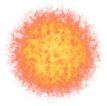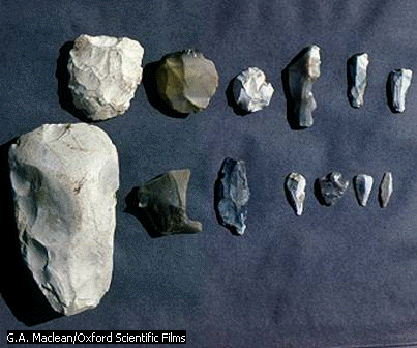 Fire
Fire Fire Fire Fire Fire
Fire
Fire Fire Fire Fire Fire
 Fire
Fire Fire Fire Fire Fire
Fire
Fire Fire Fire Fire Fire

The definition of fire is heat and light resulting from the rapid combination of oxygen, or in some cases gaseous chlorine, with other materials. The light is in the form of flame, which is composed of glowing particles of the burning material and certain gaseous products that are luminous at the temperature of the burning material.
The conditions necessary for the existence of fire are:
&ldots;the presence of a combustible substance
Two principal methods, friction and percussion have produced fire. In the friction method, friction raises the temperature of a combustible material to ignition temperature. The percussion method produces a spark to set kindling afire.
In some cultures people have used and still use chiefly the friction method, in which two pieces of wood surrounded by combustible material are rubbed together until the ignition temperature is reached. In the stick-and-groove method, a stick is rubbed in a groove in another piece of wood. In the fire-drill method, a stick is rotated rapidly in a pit in a stationary piece of wood. The stick is rotated by rubbing it between the palms of the hands or by moving back and forth a wooden bow whose string is wrapped around the stick.
The most basic percussion method of producing fire is striking together two pieces of flint, or by striking flint against pyrite. Later, steel was substituted for the pyrite. The flint-and-steel method prevailed throughout the civilized world until about 1827, when matches came into use. With matches, friction is used to heat the tip of the match to the point at which chemicals in the match head ignite.
Fire may also be produced by using a lens or curved reflector to concentrate the rays of the sun on combustible material.
The use of fire probably developed in four stages.
First, people observed about them natural sources of fire, such as volcanoes and trees set afire by lightning.
Second, they acquired fire from natural sources and used it for warmth, light, and protection from predators.
Third, they learned to make fire whenever they chose.
Finally, they learned to control fire for use in smelting metal ore, in baking pottery, and in numerous other ways to help create new technologies and make life more comfortable.
The keeping and use of fire probably had an influence in ending nomadism and consequently influenced the development of the social and political institutions connected with members of a society having a permanent home.
Glowing body of mixed gases undergoing the process of combustion. Flames generally consist of a mixture of oxygen (or air) and another gas, usually such combustible substances as hydrogen, carbon monoxide, or hydrocarbon.
A typical flame is that of a burning candle. When the candle is lighted, the heat of the match melts the wax, which is carried up the wick and then vaporized by the heat. The heat then breaks down the vaporized wax and, finally, combines with the oxygen of the surrounding air, producing a flame and generating heat and light.
Composition
The candle flame consists of three zones that are easily distinguished. The innermost zone, a nonluminous cone, is composed of a gas-air mixture at a comparatively low temperature. In the second, or luminous, cone, hydrogen and carbon monoxide are produced by decomposition and begin to react with oxygen to form water and carbon dioxide, respectively. In this cone the temperature of the flame (about 1090° to 1250° F) is great enough to dissociate the gases in the flame and produce free particles of carbon, which are heated to incandescence and then consumed. The incandescent carbon produces the characteristic yellow light of this portion of the flame. Outside the luminous cone is a third, invisible cone in which the remaining carbon monoxide and hydrogen are finally consumed.
If a cold object is introduced into the outer portions of a flame, the temperature of that part of the flame will be lowered below the point of combustion, and unburned carbon and carbon monoxide will be given off. Thus, if a porcelain dish is passed through a candle flame, it will receive a deposit of carbon in the form of soot. Operation of any kind of flame-producing stove in a room that is unventilated is dangerous because of the production of carbon monoxide, which is poisonous.
Requirements
All combustible substances require a definite proportion of oxygen for complete burning. (A flame can be sustained in an atmosphere of pure chlorine, although combustion is not complete.) In the burning of a candle, or of solids such as wood or coal, this oxygen is supplied by the surrounding atmosphere. In blowpipes and various types of gas burners, air or pure oxygen is mixed with the gas at the base of the burner so that the carbon is consumed almost instantaneously at the mouth of the burner. For this reason such flames are nonluminous. They also occupy a smaller volume and are proportionately hotter than a simple candle flame. The hottest portion of the flame of a Bunsen burner has a temperature of about 2910° F. The hottest portion of the oxygen-acetylene flames used for welding metals reaches 6330° F; such flames have a bluish-green cone in place of the luminous cone. If the oxygen supply is reduced, such flames have four cones: nonluminous, bluish-green, luminous, and invisible.
The blue-green cone of any flame is often called the reducing cone, because it is insufficiently supplied with oxygen and will take up oxygen from substances placed within it. Similarly, the outermost cone, which has an excess of oxygen, is called the oxidizing cone. Intensive studies of the molecular processes taking place in various regions of flames are now possible through the techniques of laser spectroscopy.

The earliest known human artifacts are roughly flaked stones used for chopping and scraping, found primarily in eastern Africa. Known as Oldowan tools, they date from about 2.3 million years before present, and serve to define the beginning of the Stone Age. The first toolmakers were nomadic groups of people who used the sharp edges of stone to process food. By about 40,000 years before present, humans had begun to use fire and to make a variety of tools, including pear-shaped axes, scrapers, knives, and other instruments of stone, bone, and other materials. They had also begun to use tools to make clothing and build shelters for protection from inclement weather. The use of tools can be observed in many members of the animal kingdom, but the capacity for creating tools to craft other objects distinguishes humans from all other animals.
The next big step in the history of technology was the control of fire. By striking flint against pyrites to produce sparks, people could kindle fires at will, thereby freeing themselves from the necessity of perpetuating fires obtained from natural sources. Besides the obvious benefits of light and heat, fire was also used to bake clay pots, producing heat-resistant vessels that were then used for cooking grains and for brewing and fermenting. Fired pottery later provided the crucibles in which metals could be refined. Advanced thought processes may well have first developed around the hearth, and it was there that the first domesticated animal, the dog, was tamed.